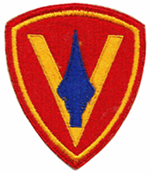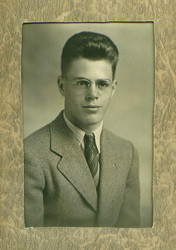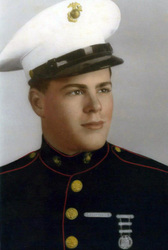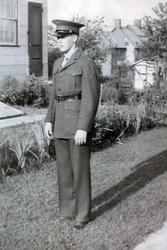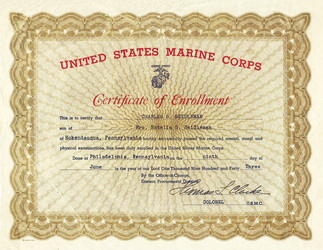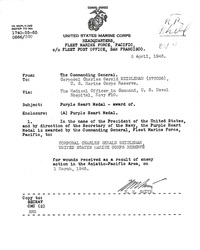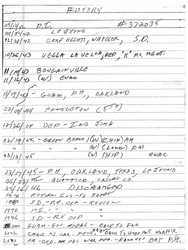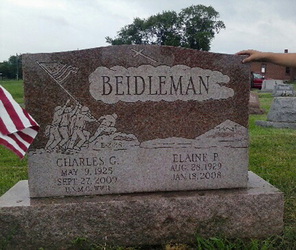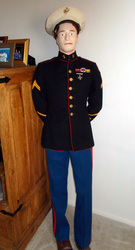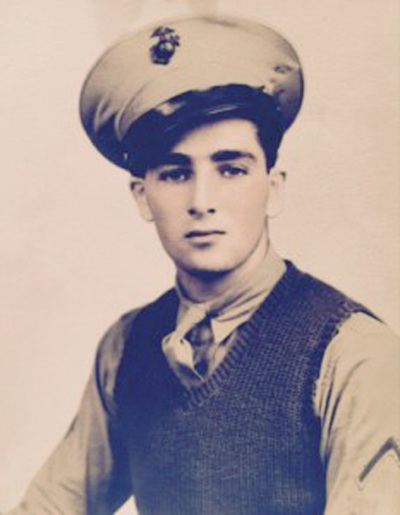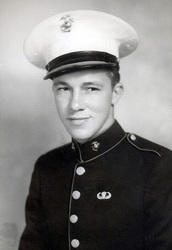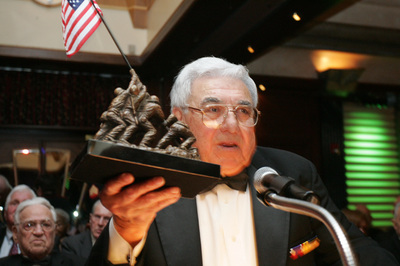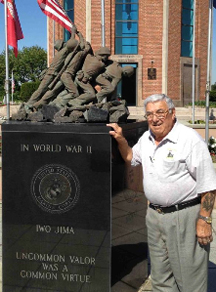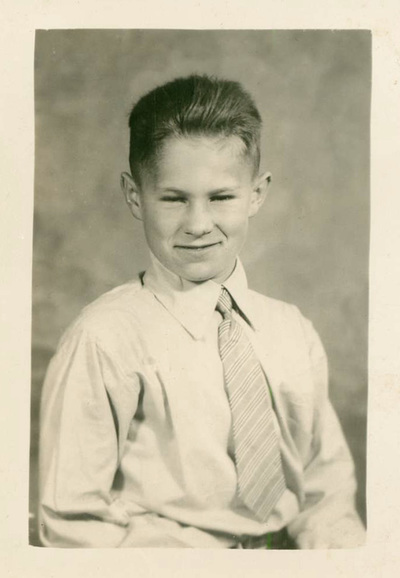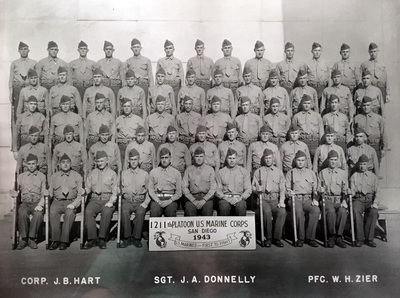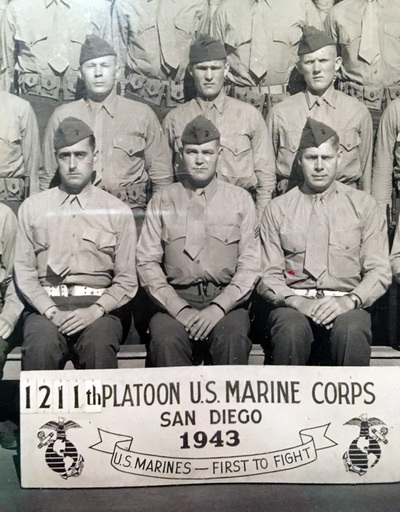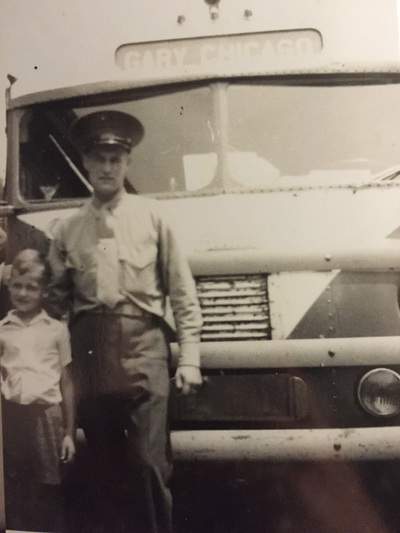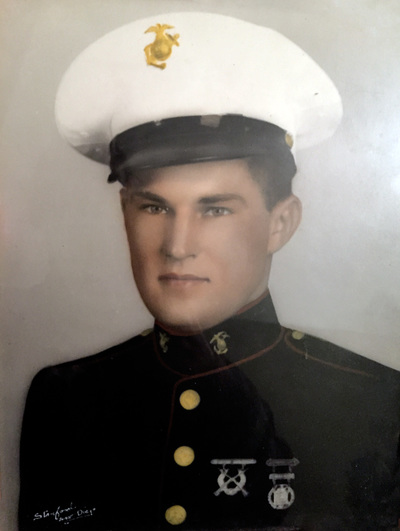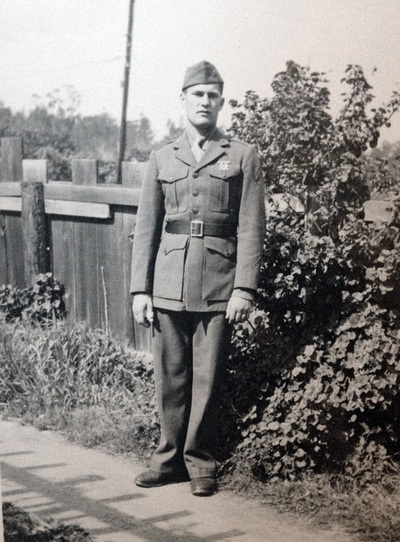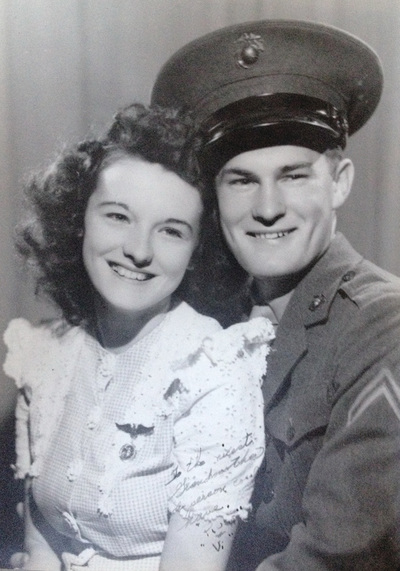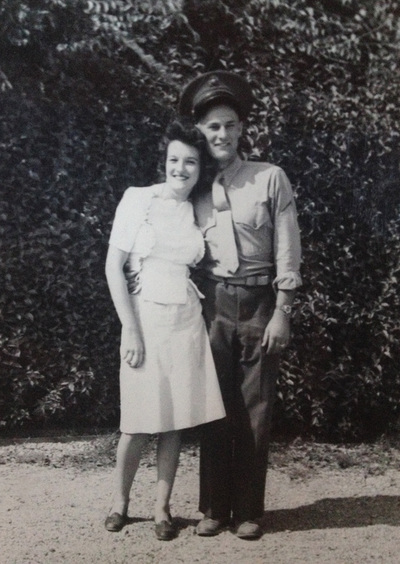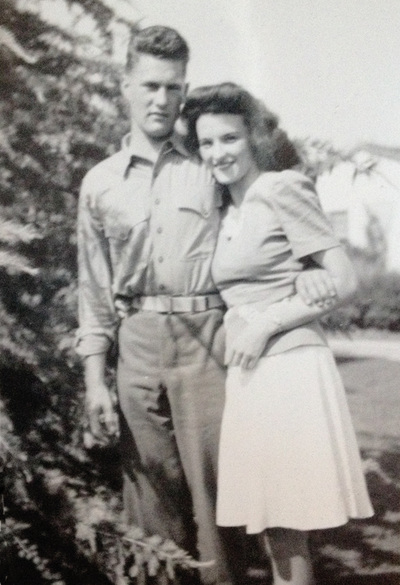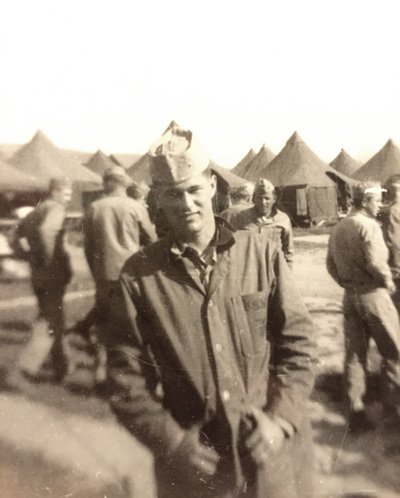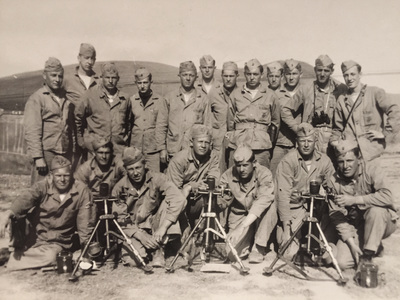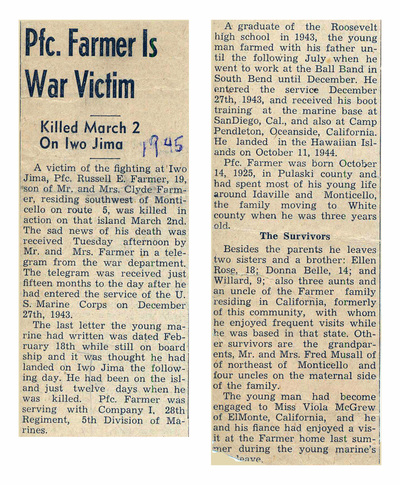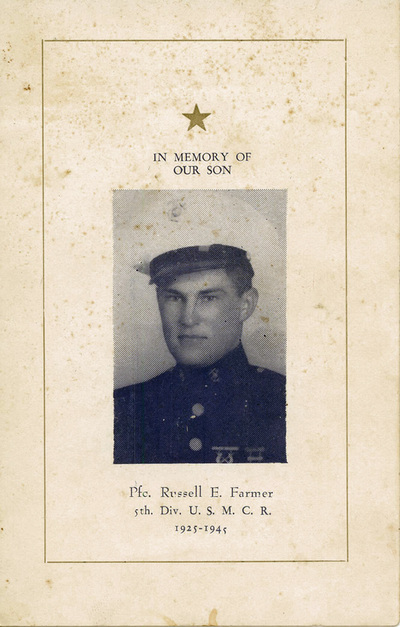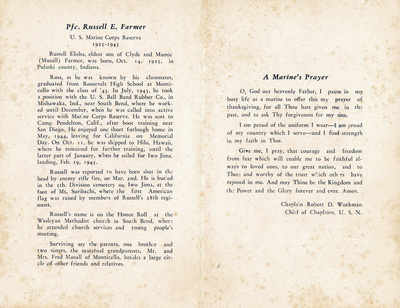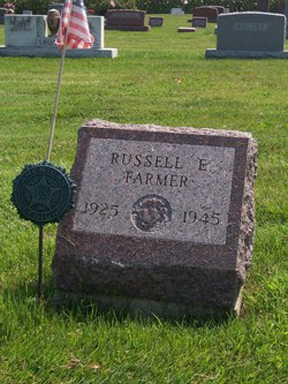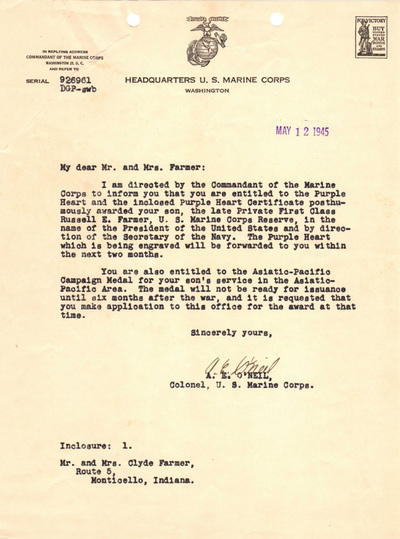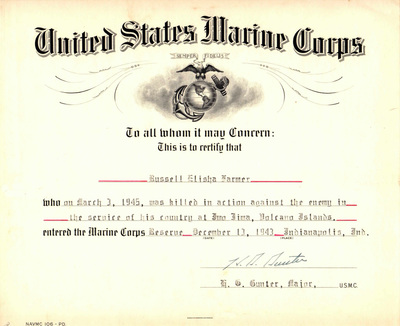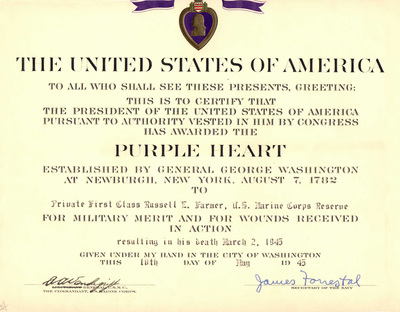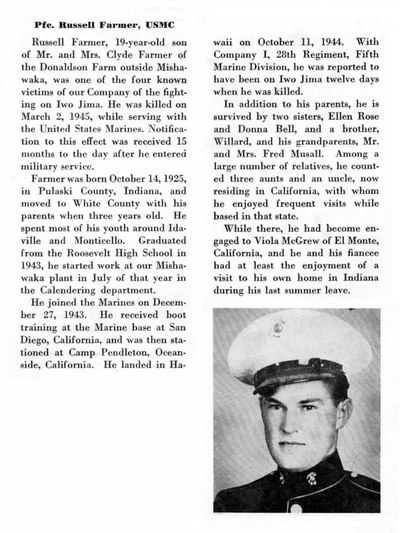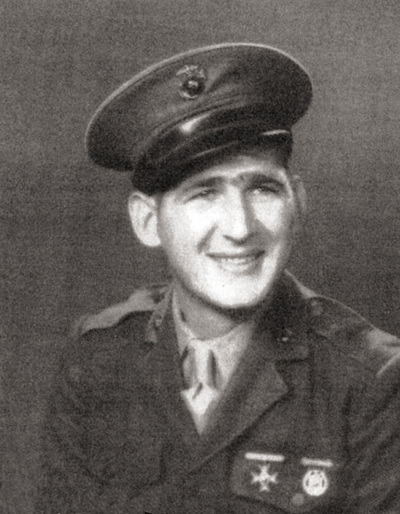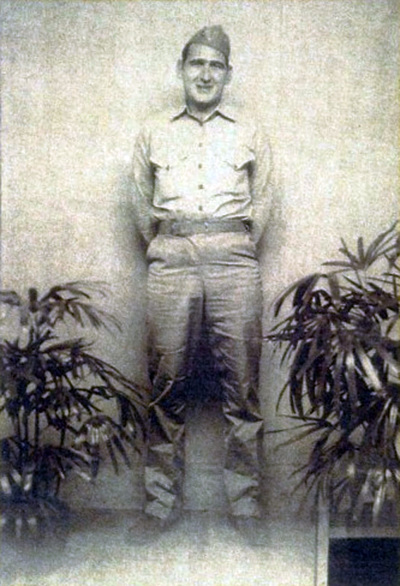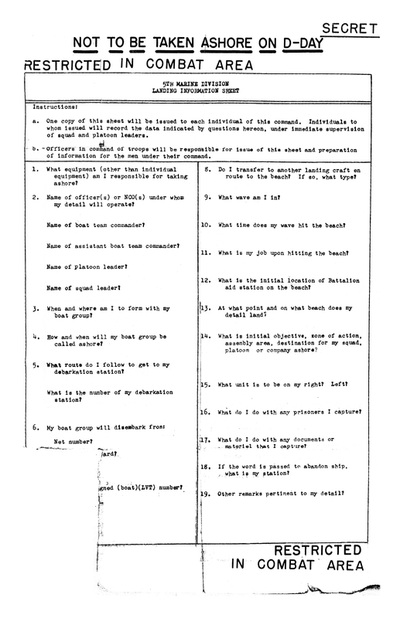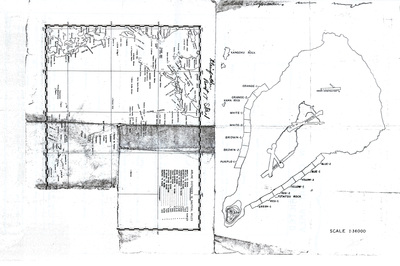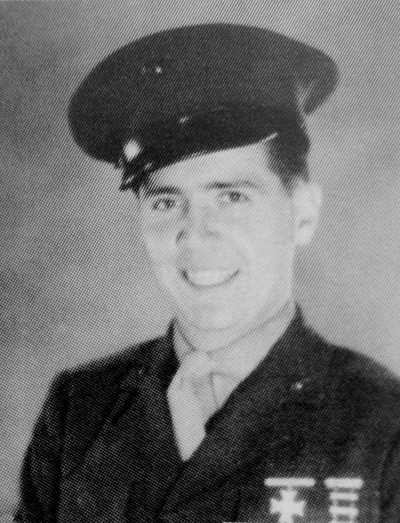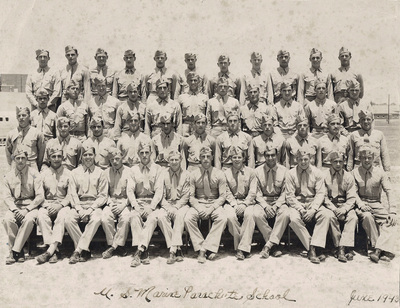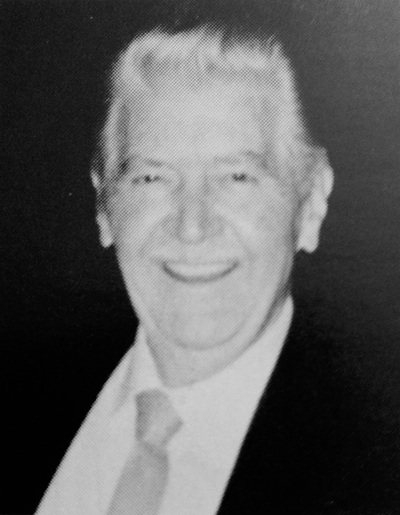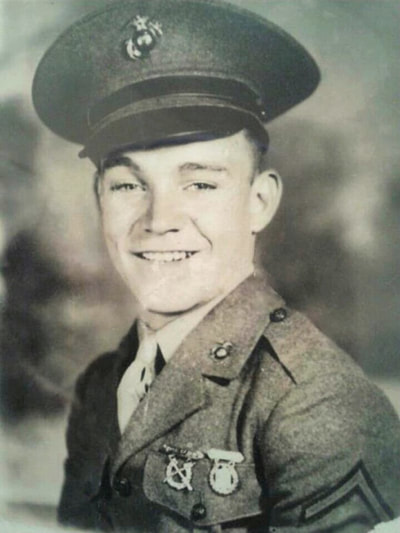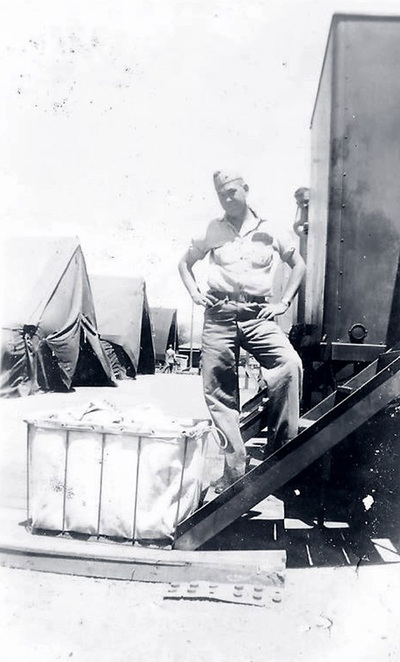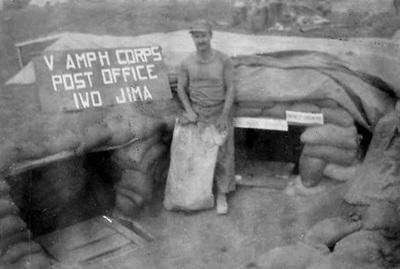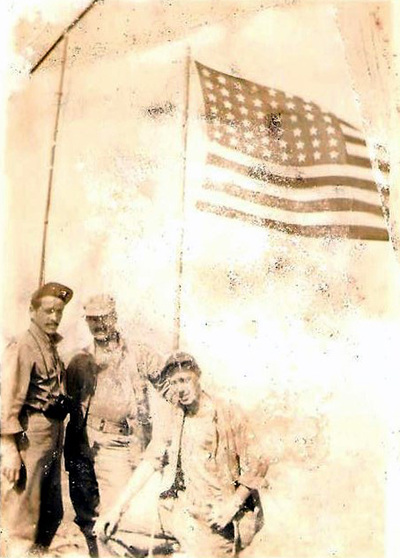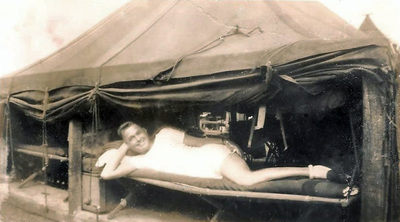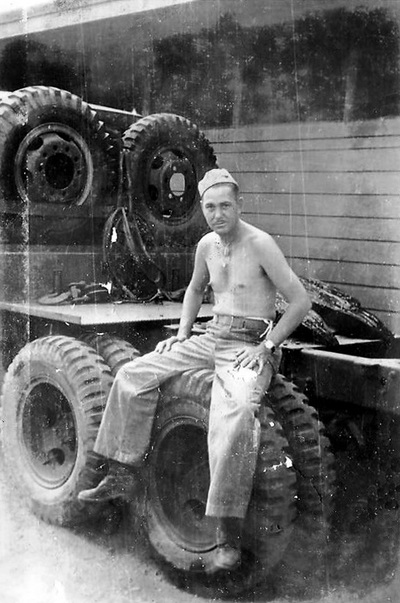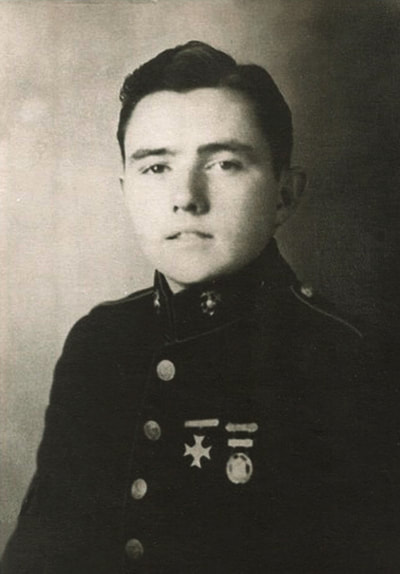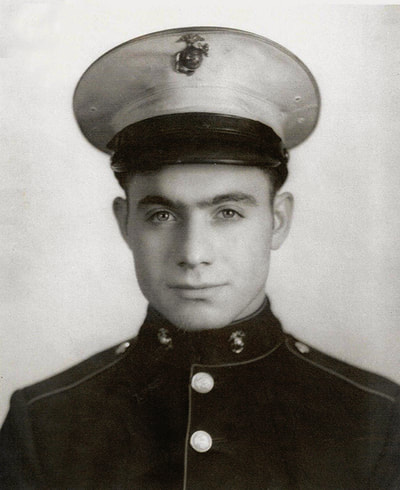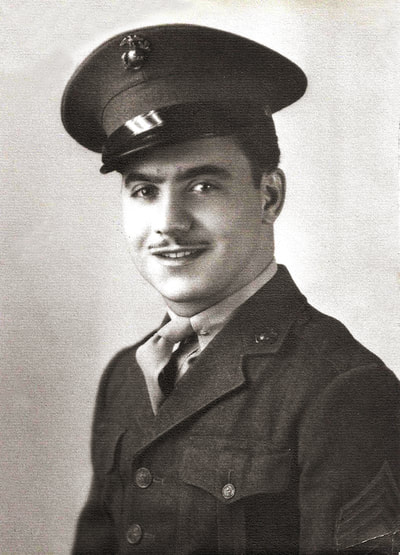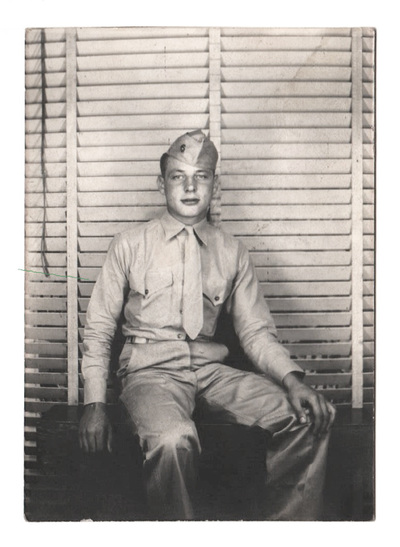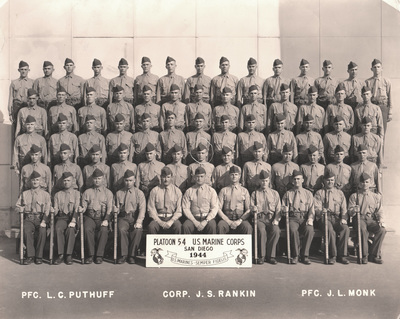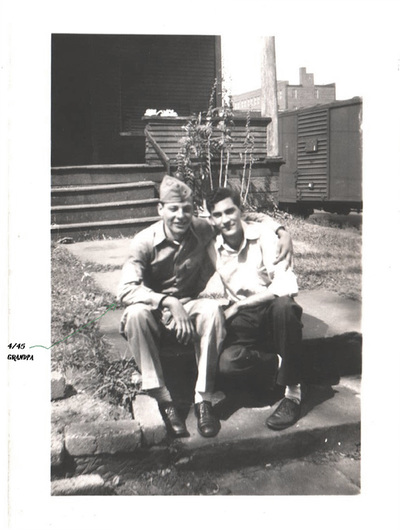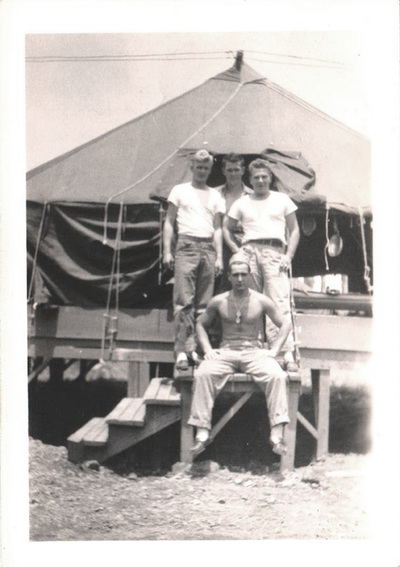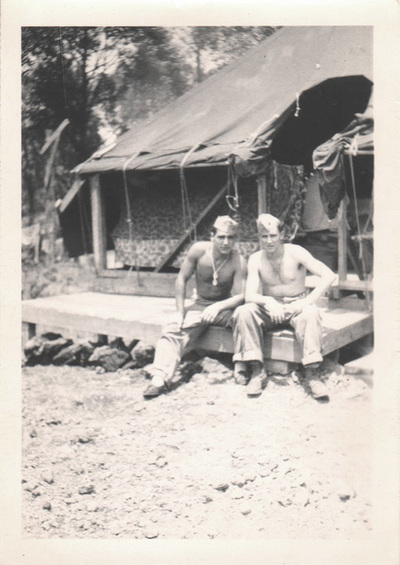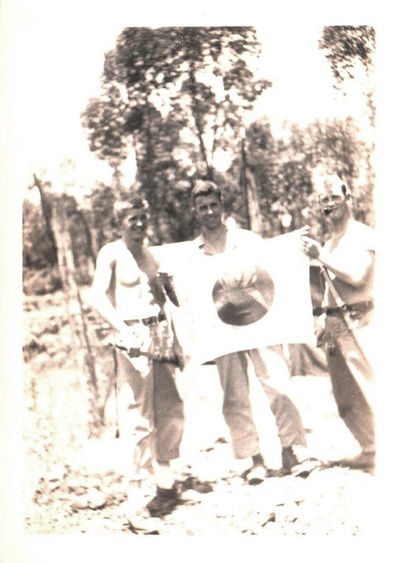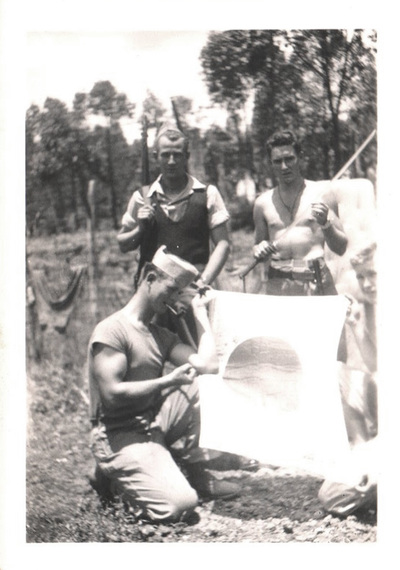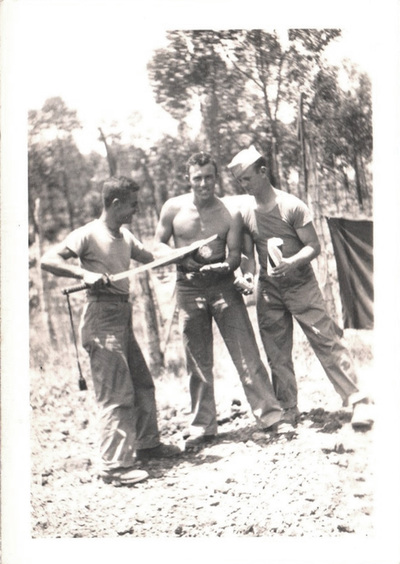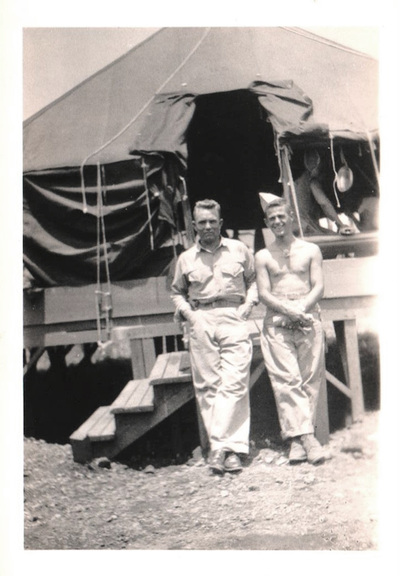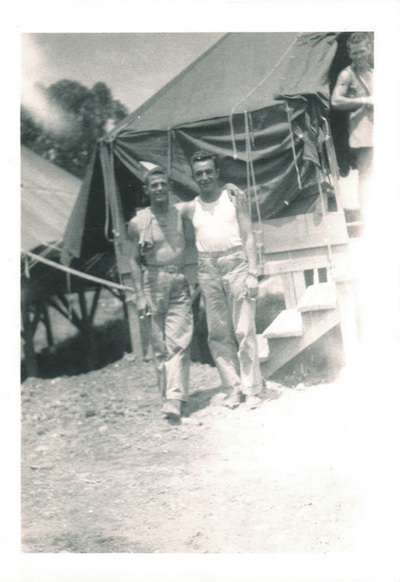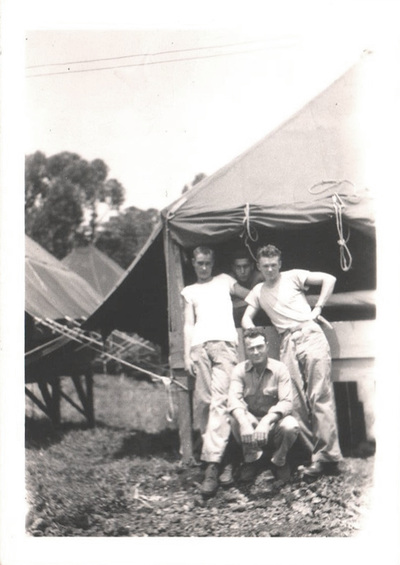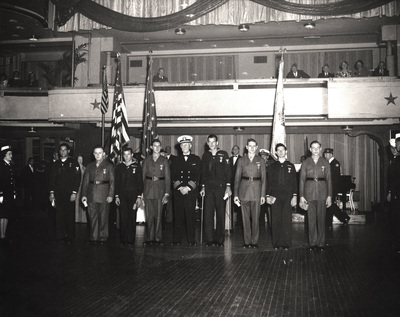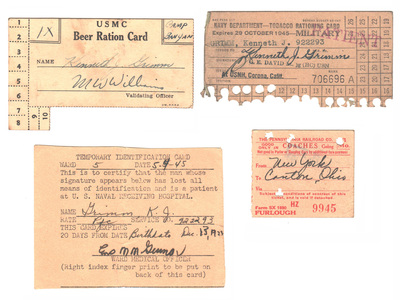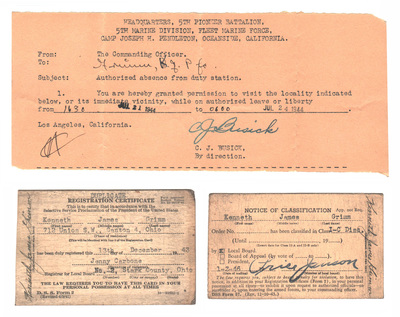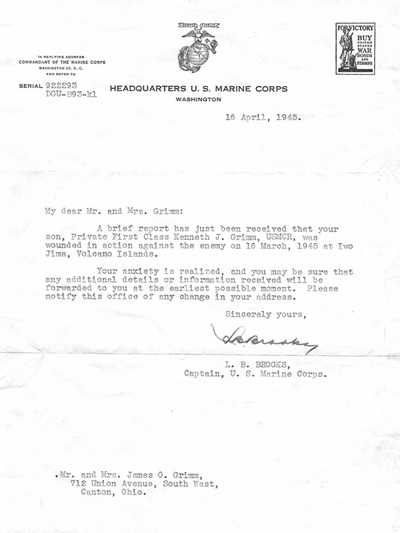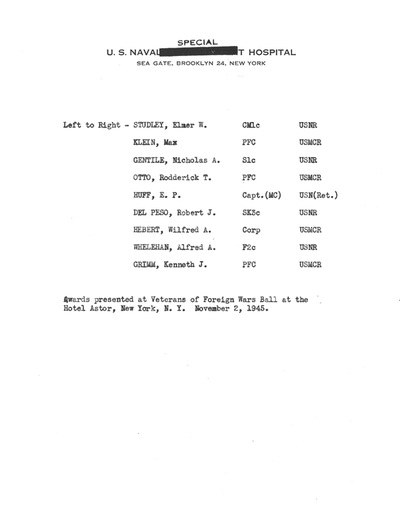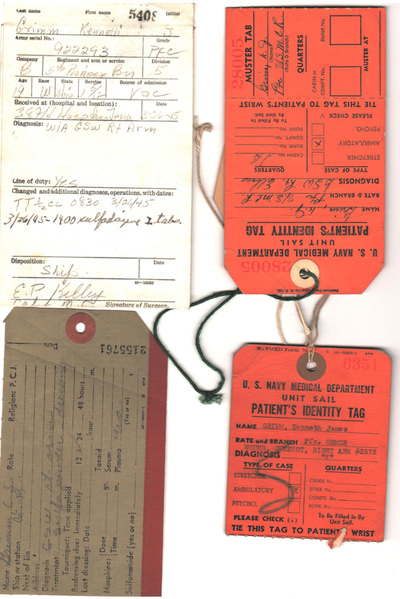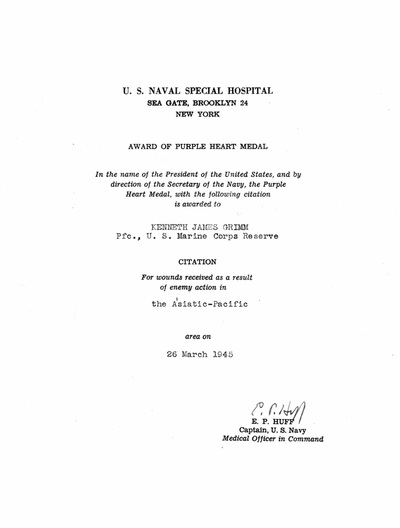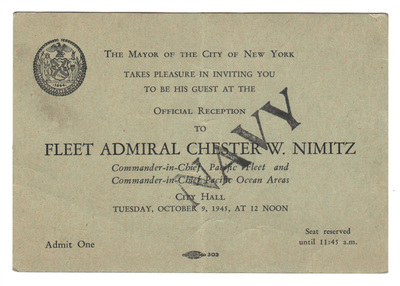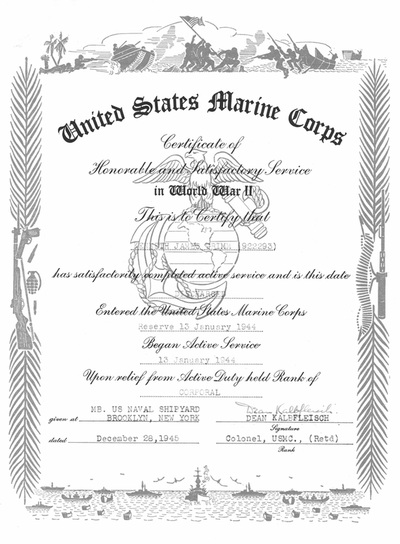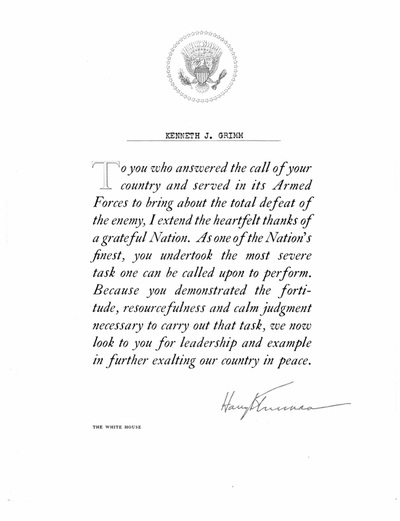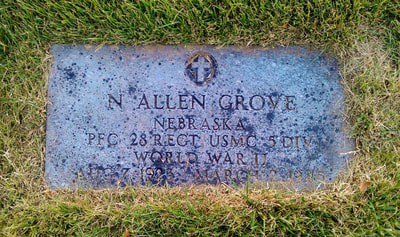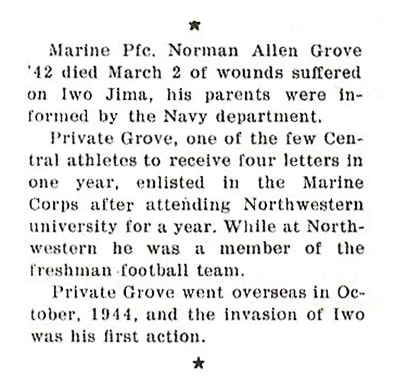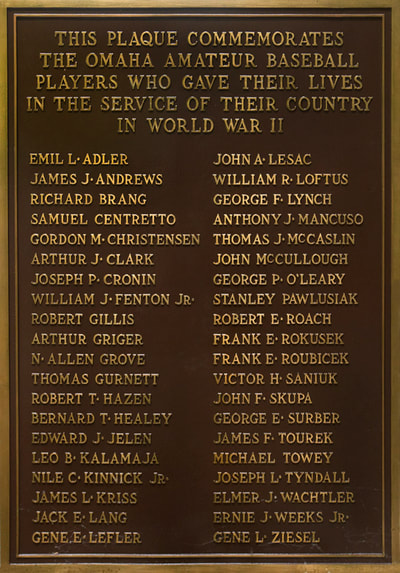|
CORPORAL
charles G. Beidleman
28TH MARINE REGIMENT / HOKENDAUQUA, PENNSYLVANIA
I recently met the family of Charles Beidlman, he was there on Iwo Jima with the 5th Marine Division. He was invited by President Ford to a lunch with other Marines who were a part of the fight for Suribachi. He was wounded in the hip on Iwo and received his fourth award for being wounded (He had served in several other major battles). According to his step daughter-in-law, he lost his voice box several years before he died, as so many other veterans he was a very heavy smoker. He learned to talk without a device and his friends and family called him "Ducky". She also told me he carried with him a brief case with all Marine Corps things in it and a flag. If he stopped at a restaurant (like McDonald's) he would open up the case and spread out his items on the table with pride. His log book/diary from Iwo Jima survived the war. He was wounded in the hip and stuffed toilet paper into the wound for the bleeding.
Story and photos submitted by Claudia LaChance.
Story and photos submitted by Claudia LaChance.
Private first class
samuel I. bernstein
5TH PIONEER BATTALION / NEW LONDON, CONNECTICUT
Samuel Irving Bernstein was born on April 11, 1924 to Morris and Rose Bernstein of New London, Connecticut. He was the youngest of five boys. He joined the United States Marine Corps on January 14, 1943. He was with the 2nd Platoon of A Company, 5th Pioneer Batallion, 5th Marine Division. He was a survivor of the last banzai attack on Iwo Jima. He was awarded the Combat Action Ribbon, Presidential Unit Citation, Good Conduct Medal, WWII Victory Medal, American Campaign Medal, The Asiatic Pacific Campaign Medal (with one Battle Star), and finally the Occupation Ribbon of WWII. He was married to Roberta Bernstein for 67 years. He was the father of three children, seven grandchildren and four great- granddaughters. Originally from New London, CT, he relocated his family to Randolph, Massachusetts, built his own home, and worked many jobs in the drapery business until 1971, when he and Roberta opened up their own business, Sam’s Drapery Workroom. He was a member of the Masons, 32nd Degree, the Shriners, and the Jewish War Veterans. He was also a founding member of Temple Beth Am and their brotherhood, where he helped to build a thriving congregation and Jewish community. Sam strongly believed in country, religion, and family. He passed away on December 27, 2015 with his family at his bedside.
Submitted by John Ratomski.
Submitted by John Ratomski.
Corporal
Glen W. Binegar
26TH MARINE REGIMENT / MURDO, SOUTH DAKOTA
When World War II broke out, Glen Binegar enlisted in the U.S. Marine Corps. He went through boot camp in San Diego, California and volunteered for the Marine Paratroopers and was then moved to Parachute Training Camp at Camp Gillespie, Calif. He was the only Marine Paratrooper from Jones County, S.D. After graduation from parachute training school, he went overseas on the USS Jane Addams. His unit, the 1st Marine Parachute Regiment, was awarded the Presidential Unit Citation while serving on the following islands: Guadalcanal, New Caledonia, Parauta, Vella LaVella, Bougainville and New Hebrides. His unit was returned from the South Pacific to Camp Pendleton in 1944. After a very brief stay, he was assigned to Company G, 3rd Bn, 26th Marines, 5th Marine Division and began preparation for the invasion of Iwo Jima. The island was invaded on Feb. 19, 1945. Glen was wounded March 2, 1945, and was hospitalized in the army hospital on Saipan. His unit again received the Presidential Unit Award and Glen was awarded the Purple Heart. While a member of the 5th Marine Division, he served on Hawaii, Oahu, Maui, Eniwitok, Saipan, Tinian and Iwo Jima. After Japan surrendered, he was involved in the occupation of Japan on Kyushu. Glen was honorably discharged Dec. 19, 1945. His best friend in the Marine Corps was Carroll L. Caples who was killed on Iwo Jima and is listed below. Glen never forgot him.
Story and photo submitted by his son, Joe Binegar.
Story and photo submitted by his son, Joe Binegar.
Private First Class
carroll l. caples
26TH MARINE REGIMENT / BALTIMORE, MARYLAND
The President of the United States of America takes pride in presenting the Silver Star (Posthumously) to Private First Class Carroll L. Caples (MCSN: 333276), United States Marine Corps, for conspicuous gallantry and intrepidity as a Rifleman serving with Company G, Third Battalion, Twenty-sixth Marines, FIFTH Marine Division, in action against enemy Japanese forces on Iwo Jima, Volcano Islands, from 24 February to 3 March 1945. Undaunted by the failure of several Marine comrades to rescue a wounded man lying approximately fifty yards forward of friendly lines, Private First Class Caples crawled across the exposed terrain and, staunchly braving a merciless concentration of enemy machine-gun and sniper fire, removed the stricken man to a position of safety. Cool and unhesitating when his squad leader subsequently fell in action, he instantly took command and led his squad with unfaltering skill and aggressiveness until fatally wounded on 3 March. By his ready initiative, dauntless courage and unfailing devotion to duty, Private First Class Caples rendered valiant service and upheld the highest traditions of the United States Naval Service. He gallantly gave his life for his country.
Private First class
ANGELO G. CIOTTA
28TH MARINE REGIMENT / LONG ISLAND, NEW YORK
I work in New York City for a Company called MSA Security that sponsors a golf out- ing and banquet every year. Last year’s outing, five Iwo Jima survivors were invited to attend and one of those men was Angelo Ciotta, President and founder of the Iwo Jima Survivors Association of New York and curator of “Memorial Park” which is a veteran memorial park located in Eisenhower Park, Long Island. To the tune of the Marine Corps Hymn played by the NYPD Pipes and Drums, these five men marched into the hall to a standing ovation and rousing applause. Some used walkers but all stood proud as George Harvey, President of MSA Security, made a donation to Angelo Ciotta . The donation is to be used be for the building and erecting of an Afghanistan/Iraq War Memorial in Memorial Park, presently in the planning stages. Angelo lives on Long Island and I recently met with him at the Memorial Park for a private tour and a personal account of his experience on Iwo Jima.
Angelo Ciotta was born in Leone, Italy and came to America in 1932 at the age of seven. His father leased 15 acres of land in Jackson Heights of which he used to create a farm. He wanted to buy the land but they wanted $150.00 an acre at that time, which Angelo’s father could not afford. This farm was part of where LaGuardia Airport is now located. When Angelo was 17 he quit high school and joined the Marine Corps in 1943. After training in Florida, Camp Pendleton, California and Hawaii, on January 7th 1945, he boarded a ship in Hawaii but no one was told where they were going. He was assigned to the 5th Marine Division, 28th Regiment. After being on the ship for 30 days, they were finally told they were going to Iwo Jima.
Angelo said, “We were shown a mock-up of the Island and where we were going to land. “ When he heard they were going to Iwo Jima, he now knew why he spent months training at a Hawaiian volcano site and why he and his fellow Marines climbed up and down one volcano a dozen times. They were 15 days from the landing. Angelo said, “We were charged with cutting across the throat of the island then make a left flank and we were supposed to take Mount Suribachi. We were told it would be a 72-hour operation to secure Suribachi and the other regiments would secure the rest of the island, get back aboard ship, to destination unknown.” That didn’t happen and Angelo said it took two days to just cut across the island under intense combat conditions crawling in the black sand of the Island. The enemy was entrenched and the advancing Marines had to fight for every foot they moved.
I asked Angelo if he saw the flag go up. Angelo said, “The flag went up on the 5th day, we heard it, I was at the bottom of the hill. Guys were yelling “the flag is up, the flag is up” and the Island is secure. Not true, because the Japanese were able to go from one end of the island to the other without ever coming up from underground.” Angelo also said, “The second flag raising wasn’t really a staged event. The second flag was bigger and they switched flags so the Marines could see the bigger flag. It wasn’t done for a photo opportunity, although the most famous wartime photo was taken at that moment”.
Angelo’s job was demolition and his job was to destroy the caves, tunnels, bunkers and pillboxes. He threw explosive charges into the tunnel entrances, which closed them off. They also used flamethrowers and napalm to clear the tunnels as Angelo described the brutality of this battle. Also, he said that the enemy had 55-gallon oil drums buried just beneath the surface of the ground. He said you could feel them when you stepped on them. Inside the drums were enemy soldiers and they would pop up and start firing. Angelo said explosives were the solution to that problem also. Angelo explained that all the explosive charges were C-4 and he used time fuse and a blasting cap to initiate the charges. Time fuse burns at a certain rate and when his target was an enemy pillbox, he had to use a short fuse so the enemy could not throw the charge back out of the bunker. He went on to say, that he held the record for the shortest time fuse charge on Iwo Jima. He cut the time fuse to allow only seven seconds before the charge would go off. While under intense fire, he had to run up a hill, throw the charge into the pillbox, and dive for cover. He made it, destroying the pillbox before the enemy could throw it back. Angelo smiled and said, “I was pretty fast in my day.”
The brutality of this battle is well documented in our military history. There was no place to run or hide; the rear area was only yards behind the front line. The Japanese Army was well fortified and the advancing Marines fought hard for every inch they advanced. On the 21st day, the battle ended for Angelo. He was assigned by his CO to take a detail out to pick up some wounded Marines caught in the crossfire. So using smoke grenades to obscure his movements he crawled over a knoll to reach the wounded Marines but a bullet found its mark into Angelo’s knee. Someone called for a stretcher but Angelo said ‘no’ to the stretcher. He didn’t want to expose more men to the enemy fire carrying a stretcher, so he crawled back over the knoll on his own. The bullet tore through his knee blowing out the back of his leg. He patched himself up as best he could and waited for the corpsman. Unable to walk he was carried to a safer area. He was eventually went to Guam where he was treated for his wound in a field hospital. Angelo said, “I then spent 10 days on a ship back to Hawaii. While on that ship we learned President Roosevelt had died.” Angelo spent time in several hospitals doing rehabilitation then was eventually discharged at Camp Lejeune. He was home when the Atomic Bomb was dropped. Angelo said “We would have lost another half million men if they didn’t drop that bomb”.
After the war Angelo would work in a variety of occupations including the retail business, owner of a delicatessen, Grumman Aircraft and in the construction business. However, for the last 10 years, his life work has been the “Memorial Park” at Eisenhower Park, Long Island. Using private donations and some public funding from Nassau County he has built a war memorial park well worth visiting. I urge everyone to visit this park, which is located adjacent to the Golf Driving Range at Eisenhower Park, East Meadow, New York.
Story written by Dennis M. Small
Story submitted by John Ratomski
Angelo Ciotta was born in Leone, Italy and came to America in 1932 at the age of seven. His father leased 15 acres of land in Jackson Heights of which he used to create a farm. He wanted to buy the land but they wanted $150.00 an acre at that time, which Angelo’s father could not afford. This farm was part of where LaGuardia Airport is now located. When Angelo was 17 he quit high school and joined the Marine Corps in 1943. After training in Florida, Camp Pendleton, California and Hawaii, on January 7th 1945, he boarded a ship in Hawaii but no one was told where they were going. He was assigned to the 5th Marine Division, 28th Regiment. After being on the ship for 30 days, they were finally told they were going to Iwo Jima.
Angelo said, “We were shown a mock-up of the Island and where we were going to land. “ When he heard they were going to Iwo Jima, he now knew why he spent months training at a Hawaiian volcano site and why he and his fellow Marines climbed up and down one volcano a dozen times. They were 15 days from the landing. Angelo said, “We were charged with cutting across the throat of the island then make a left flank and we were supposed to take Mount Suribachi. We were told it would be a 72-hour operation to secure Suribachi and the other regiments would secure the rest of the island, get back aboard ship, to destination unknown.” That didn’t happen and Angelo said it took two days to just cut across the island under intense combat conditions crawling in the black sand of the Island. The enemy was entrenched and the advancing Marines had to fight for every foot they moved.
I asked Angelo if he saw the flag go up. Angelo said, “The flag went up on the 5th day, we heard it, I was at the bottom of the hill. Guys were yelling “the flag is up, the flag is up” and the Island is secure. Not true, because the Japanese were able to go from one end of the island to the other without ever coming up from underground.” Angelo also said, “The second flag raising wasn’t really a staged event. The second flag was bigger and they switched flags so the Marines could see the bigger flag. It wasn’t done for a photo opportunity, although the most famous wartime photo was taken at that moment”.
Angelo’s job was demolition and his job was to destroy the caves, tunnels, bunkers and pillboxes. He threw explosive charges into the tunnel entrances, which closed them off. They also used flamethrowers and napalm to clear the tunnels as Angelo described the brutality of this battle. Also, he said that the enemy had 55-gallon oil drums buried just beneath the surface of the ground. He said you could feel them when you stepped on them. Inside the drums were enemy soldiers and they would pop up and start firing. Angelo said explosives were the solution to that problem also. Angelo explained that all the explosive charges were C-4 and he used time fuse and a blasting cap to initiate the charges. Time fuse burns at a certain rate and when his target was an enemy pillbox, he had to use a short fuse so the enemy could not throw the charge back out of the bunker. He went on to say, that he held the record for the shortest time fuse charge on Iwo Jima. He cut the time fuse to allow only seven seconds before the charge would go off. While under intense fire, he had to run up a hill, throw the charge into the pillbox, and dive for cover. He made it, destroying the pillbox before the enemy could throw it back. Angelo smiled and said, “I was pretty fast in my day.”
The brutality of this battle is well documented in our military history. There was no place to run or hide; the rear area was only yards behind the front line. The Japanese Army was well fortified and the advancing Marines fought hard for every inch they advanced. On the 21st day, the battle ended for Angelo. He was assigned by his CO to take a detail out to pick up some wounded Marines caught in the crossfire. So using smoke grenades to obscure his movements he crawled over a knoll to reach the wounded Marines but a bullet found its mark into Angelo’s knee. Someone called for a stretcher but Angelo said ‘no’ to the stretcher. He didn’t want to expose more men to the enemy fire carrying a stretcher, so he crawled back over the knoll on his own. The bullet tore through his knee blowing out the back of his leg. He patched himself up as best he could and waited for the corpsman. Unable to walk he was carried to a safer area. He was eventually went to Guam where he was treated for his wound in a field hospital. Angelo said, “I then spent 10 days on a ship back to Hawaii. While on that ship we learned President Roosevelt had died.” Angelo spent time in several hospitals doing rehabilitation then was eventually discharged at Camp Lejeune. He was home when the Atomic Bomb was dropped. Angelo said “We would have lost another half million men if they didn’t drop that bomb”.
After the war Angelo would work in a variety of occupations including the retail business, owner of a delicatessen, Grumman Aircraft and in the construction business. However, for the last 10 years, his life work has been the “Memorial Park” at Eisenhower Park, Long Island. Using private donations and some public funding from Nassau County he has built a war memorial park well worth visiting. I urge everyone to visit this park, which is located adjacent to the Golf Driving Range at Eisenhower Park, East Meadow, New York.
Story written by Dennis M. Small
Story submitted by John Ratomski
Private First Class
RUSSELL E. FARMER
28TH MARINE REGIMENT / MONTICELLO, INDIANA
Russell Elisha Farmer was born in Pulaski County, Indiana on October 14, 1925. His parents were Clyde and Mamie Farmer. His younger siblings were Ellen Rose Farmer, Donna Bell Farmer and Willard Frederick Farmer. Russell graduated from Roosevelt High School in 1943 and worked at a Mishawaka plant before joining the Marine Corps on December 27, 1943. He went through basic training at San Diego and was then stationed at Camp Pendleton. Pfc. Farmer served as a Flamethrower with I Company, 28th Marines, 5th Marine Division. He arrived in Hawaii on October 11, 1944. He was on Iwo Jima for 12 days when he was killed on March 2, 1945. Reports indicated that he was shot in the head by a Japanese sniper. He was engaged before he was deployed and had met his fiancée, Viola McGrew from El Monte, California while he was stationed in California.
He received the Purple Heart for his sacrifice during the war. He also received the Asiatic-Pacific Campaign Medal. He was initially buried on Iwo Jima until his family requested his body be moved and buried in his hometown in Chalmers, White County, Indiana where his grave currently resides. He was buried in his uniform with his dog tags. When he was of age, his brother, Willard, joined the Army and trained as a sniper to honor Russell's sacrifice.
I have no personal stories, since I never met him. My grandfather was the only tie to him, and he was only 10 when he learned of his brother’s death. All I know is that Russell's death completely changed his family. My grandfather could barely talk about him because every time he did he would cry, so he mostly kept to himself about his brother. He can be seen in the photo of Russell with his arm around my young grandpa standing in front of the bus.
Story and photos submitted by his great niece, Lauren Farmer.
He received the Purple Heart for his sacrifice during the war. He also received the Asiatic-Pacific Campaign Medal. He was initially buried on Iwo Jima until his family requested his body be moved and buried in his hometown in Chalmers, White County, Indiana where his grave currently resides. He was buried in his uniform with his dog tags. When he was of age, his brother, Willard, joined the Army and trained as a sniper to honor Russell's sacrifice.
I have no personal stories, since I never met him. My grandfather was the only tie to him, and he was only 10 when he learned of his brother’s death. All I know is that Russell's death completely changed his family. My grandfather could barely talk about him because every time he did he would cry, so he mostly kept to himself about his brother. He can be seen in the photo of Russell with his arm around my young grandpa standing in front of the bus.
Story and photos submitted by his great niece, Lauren Farmer.
private
Henry A. Ford
27TH REPLACEMENT BATTALION / KANSAS CITY, MISSOURI
My grandfather Henry Albert Ford was born in Kansas City on June 26, 1918. His parents were Charles Albert Ford and Hulda Ida Toll. He served as a cook in the 5th Division with the 27th Replacement Battalion. I discovered his copy of the Landing Information Sheet in my Aunt's house which details 19 items that inform the invasion force what to do in different situations. It is marked SECRET and was NOT TO BE TAKEN ASHORE ON D-DAY. On the back side is a map of IWO with color coded landing areas of the north and south beaches. My grandfather died on August 3, 1992 in Tulsa, Oklahoma.
Story and photos submitted by his grandson, J. D. Ford.
Story and photos submitted by his grandson, J. D. Ford.
Corporal
Patrick C. Foyle
26TH MARINE REGIMENT / BRONX, NEW YORK
Patrick Casey Foyle was born on June 3, 1921 in the Bronx, New York. He enlisted in the Marine Corps in July 1942. He completed basic training at Parris Island, South Carolina. He was then certified as a member of the elite Parachute Corps on May 4, 1943. He was sent to Camp Pendleton where he was assigned to Fox Company, 2nd Battalion, 26th Marines, 5th Marine Division. He trained at Camp Tarawa, Hawaii and then sailed off to combat. He landed in the first wave at Iwo Jima on February 19, 1945. He was wounded on February 27 and was awarded the Purple Heart on March 15, 1945. F/2/26 suffered the most casualties of any unit in three Marine Divisions on Iwo Jima. He was then discharged from the Marine Corps in January 1946. After serving in the Marines, Foyle worked in New York City at Ingersoll Rand where he met his wife, Eileen. He later worked as the General Manager of the New York restaurants Starks, Blums and Bun n' Burger. In May of 1987, he retired with his wife to Oceanside, California where their home overlooked Camp Pendleton, holding priceless memories for him. In 1988, F/2/26 held its first reunion ever and had 70 Fox Company veterans in attendance. He and Eileen had five daughters, two sons, and seven grandchildren. Patrick Casey Foyle pass away on December 6, 1989.
Story and photos submitted by his son, Terry Foyle.
Story and photos submitted by his son, Terry Foyle.
PRIVATE FIRST CLASS
FRANK A. FRANKS
5TH PIONEER BATTALION
Photo submitted by his grandson, David Taggart.
Corporal
George D. Gibson
2ND LAUNDRY COMPANY / DAYTON, TEXAS
My dad's name was George D. Gibson. He was born on September 10, 1910 in Dayton, Texas to Benjamin and Flora Belle Underwood Gibson. When he enlisted, Dad had owned Gibson Cleaners in Hempstead, Texas for 10 years. So the Marine Corps definitely put him in the right place. He left San Diego aboard the USS Franklin on May 31, 1944. He arrived at Pearl Harbor on June 6, 1944. On Iwo Jima he served as an Assistant Foreman in the 4th Platoon of 2nd Laundry Company. He was also a tailor making "beer" money putting rear pockets in issued pants. His old "sea bag" says Saipan, Tinian, and Guam; yet he served on Iwo Jima - pictures of the Post Office and first flag prove it. He Participated in the Occupation of Japan on the Island of Kyushu while a member of the Eighth Service Regiment. He sailed from Sasebo Harbor, Kyushu, Japan on the USS Fallon on October 12, 1945 and arrived back in San Diego on October 29, 1945.
He was discharged on November 9, 1945. Dad rejoined the family in Houston, Texas. Mom had sold the cleaners in Hempstead and moved my brother and me to Houston. For a short time Dad was the Superintendent of the Naval Hospital Laundry in Houston. Citing "too many feather merchants" he quit and opened Gibson Cleaners in Jacinto City, Texas a suburb of Houston. He sold his business in Jacinto City in the 60's. He opened a new Gibson Cleaners in Houston. In his retirement years he used his sewing machine to do alterations for neighbors and the neighborhood cleaners. He died in the VA Hospital in Houston, Texas on June 28, 1982. He is buried beside his wife, Rosetta, in the Beth Yeshurun Cemetery in Houston, Texas. He had two sons David (Lt. Col USAF, Ret) and Harlan.
Story and photos submitted by his son, David Gibson.
He was discharged on November 9, 1945. Dad rejoined the family in Houston, Texas. Mom had sold the cleaners in Hempstead and moved my brother and me to Houston. For a short time Dad was the Superintendent of the Naval Hospital Laundry in Houston. Citing "too many feather merchants" he quit and opened Gibson Cleaners in Jacinto City, Texas a suburb of Houston. He sold his business in Jacinto City in the 60's. He opened a new Gibson Cleaners in Houston. In his retirement years he used his sewing machine to do alterations for neighbors and the neighborhood cleaners. He died in the VA Hospital in Houston, Texas on June 28, 1982. He is buried beside his wife, Rosetta, in the Beth Yeshurun Cemetery in Houston, Texas. He had two sons David (Lt. Col USAF, Ret) and Harlan.
Story and photos submitted by his son, David Gibson.
PRIVATE
GEORGE TRUITT GRANT, JR.
27TH MARINE REGIMENT / GADSDEN, ALABAMA
Born December 24, 1926. Died December 10, 1993.
Was later assigned to B Company of the 5th Tank Battalion.
Photo submitted by his son, David Grant.
Was later assigned to B Company of the 5th Tank Battalion.
Photo submitted by his son, David Grant.
PRIVATE
HENRY EDWIN GRANT
27TH MARINE REGIMENT / SAN FRANCISCO, CALIFORNIA
Born December 7, 1925. Died March 11, 1945.
Buried at Golden Gate National Cemetery, San Francisco
Photo submitted by Bob Harik.
Buried at Golden Gate National Cemetery, San Francisco
Photo submitted by Bob Harik.
Field cook
victor P. greggi
5TH ENGINEER BATTALION / BARNESBORO, PENNSYLVANIA
Victor P. Greggi was born in Barnesboro, Pennsylvania. After World War II he was a resident of Lyndhurst, New Jersey for 66 years. He was a member of the Operating Engineer Local #825, Springfield for over 50 years when he retired in 1993. He was also a member of the American Legion #139 and VFW Post #3549 both of Lyndhurst. He died on February 18, 2013.
Photos submitted by Eric W. Krelle
Photos submitted by Eric W. Krelle
Private First Class
KENNETH J. GRIMM
5TH PIONEER BATTALION / CANTON, OHIO
Photos submitted by his grandson, Larry Freda.
